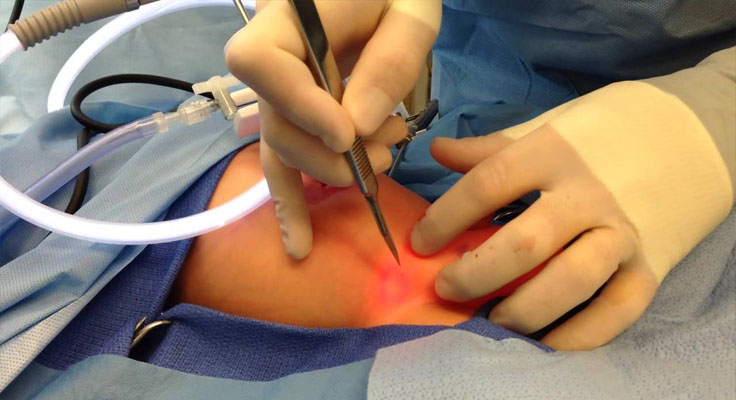
What is a Hernia?
A hernia is the protrusion of an organ through the structure or muscle that usually contains it. The condition occurs most often in the abdominal wall, when the intestine pushes through a weak spot in the wall. The most common abdominal wall hernia is an inguinal hernia.
What are some types of hernias?
Some of the most common types of hernias are explained below.
Inguinal hernias:
in the inner groin area, occur when the intestine protrudes through either of two passages in the lower abdominal wall called inguinal canals. Researchers have estimated that about 27% of men and 3% of women will develop an inguinal hernia at some point in their lives.Femoral hernias:
in the upper thigh/outer groin area, occur in deeper passages called femoral canals. They are much less common than inguinal hernias and are far more likely to occur in women than in men. They also present a higher risk of complications if they are not repaired.Ventral hernias :
occur though an opening in the muscles of the abdomen. There are three types of ventral hernias- Epigastric hernias occur above the bellybutton.
- Incisional hernias are caused by a weakening of the abdominal muscle resulting
from an incision made during a previous abdominal surgery. - Umbilical hernias, which occur near the bellybutton, are most common in newborns, especially those born prematurely. These hernias usually close on their own by the time the child turns 4. Umbilical hernias can be more problematic when they occur in adults.
Hiatal hernias
occur when the upper part of the stomach bulges into the chest through a small opening (the hiatus) in the diaphragm. The hiatus allows the esophagus, which carries food from the mouth to the stomach, to pass through the diaphragm
What are some hernia symptoms?
A common symptom of most hernias is a noticeable lump or bulge, and potentially some discomfort or pain. The lump or bulge may not always be present; for example, it might go away when you lie down. Symptoms may worsen when you are standing, straining, or lifting heavy objects. Most hernias can be confirmed by a doctor during a physical exam, but sometimes imaging is necessary.
What are the options for hernia surgery?
There are two primary options:
Open hernia surgery.
The surgeon makes a cut in the groin to view and repair the hernia. After repairing the hernia, the surgeon uses stitches alone or stitches and a piece of mesh to close the abdominal wall. The mesh is designed to strengthen the weak area of the abdominal wall where the hernia occurred.
Laparoscopic hernia surgery.
The surgeon makes several small cuts in the lower abdomen and inserts special tools to view and repair the hernia. The surgeon typically uses a piece of mesh to close and strengthen the abdominal wall. There are some surgeons who opt for robotic repair, which means they sit at a console controlling robotic arms that perform the surgery.
What is laparoscopic (minimally invasive) hernia repair surgery?
Laparoscopic (minimally invasive) hernia repair uses a laparoscope, a thin, telescope-like instrument that is inserted through a small incision at the umbilicus (belly button). This procedure is usually performed under general anesthesia, so before the surgery, you will have an evaluation of your general state of health, including a history, physical exam (and possibly lab work) and an electrocardiogram (EKG).
You will not feel pain during this surgery. The laparoscope is connected to a tiny video camera, smaller than a dime, that projects an “inside view” of your body onto television screens in the operating room.
The abdomen is inflated with a harmless gas (carbon dioxide), which creates space to allow your doctor to view your internal structures. The peritoneum (the inner lining of the abdomen) is cut to expose the weakness in the abdominal wall. Mesh is placed on the inside to cover the defects in the abdominal wall and strengthen the tissue.
After the procedure is completed, the small abdominal incisions are closed with a stitch or two or with surgical tape. Within a few months, the incisions are barely visible.
Benefits of laparoscopic hernia surgery
surgery include three tiny scars rather than one larger incision, less pain after surgery, a quicker return to work and a shorter recovery time (days instead of weeks).
